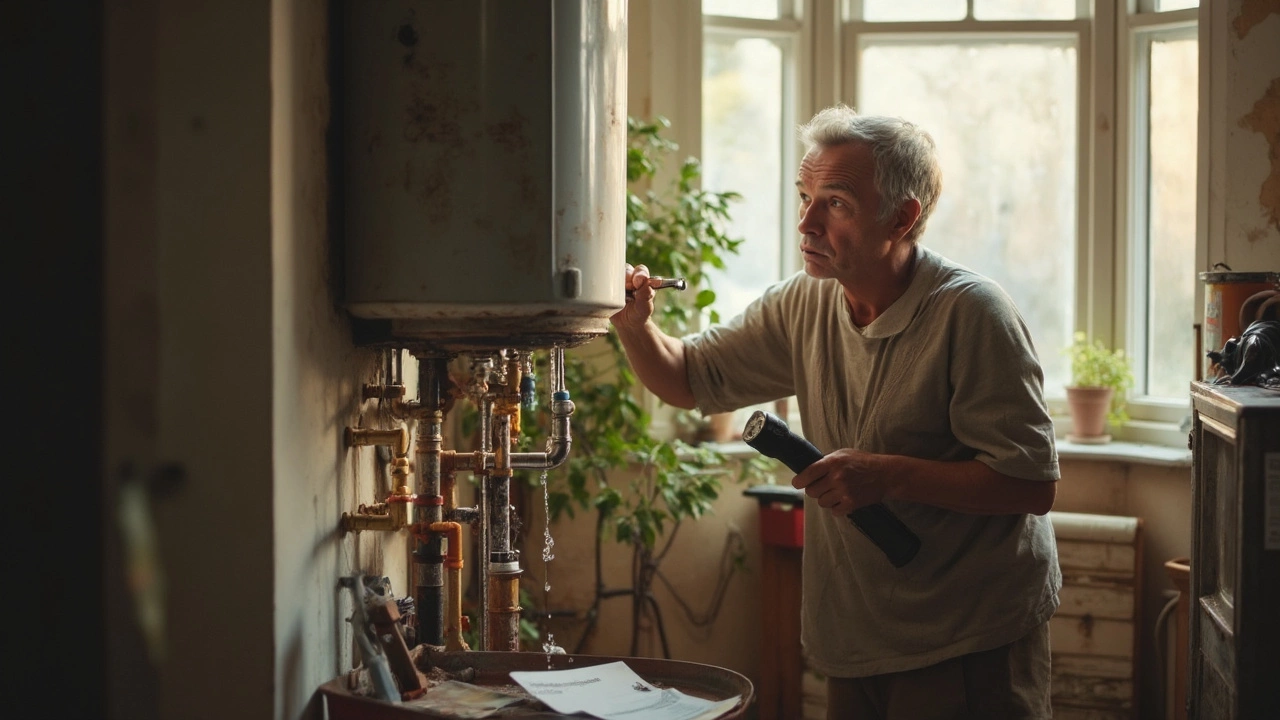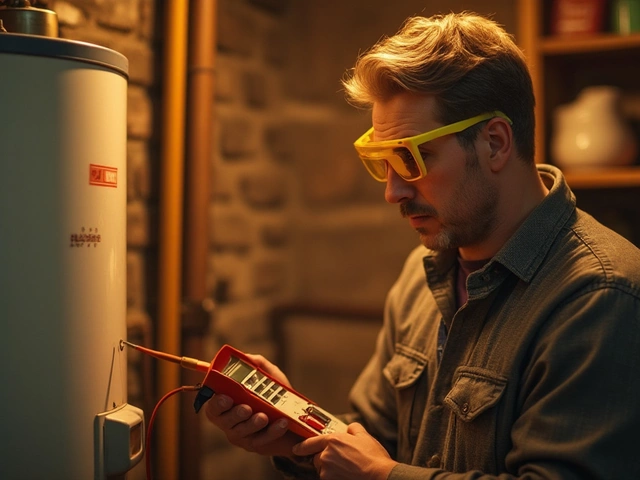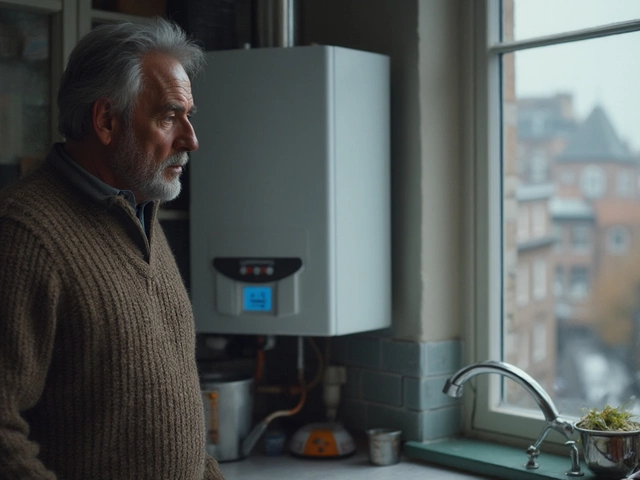Having hot water on tap feels like something you can always count on—until the day you turn the faucet and get nothing but cold. A water heater doesn’t usually quit all at once. Instead, it acts up first. If you know the early warning signs, you can avoid days without hot water and the risk of a flooded basement.
Notice water around the base of your tank? That's not just a minor leak. It could be a sign the inside of the tank is rusting through, and that repair might not cut it. Or maybe you hear strange popping and rumbling coming from your water heater. That’s usually mineral buildup inside, a clue that the tank is working harder than it should. Let those noises drag on too long, and you could be shopping for a new heater sooner than you planned.
- The Typical Lifespan: When to Start Worrying
- Warning Signs You Shouldn't Ignore
- Common Symptoms vs. Simple Fixes
- Why Replacement Beats Constant Repair
- Smart Tips to Stretch Your Heater’s Life
The Typical Lifespan: When to Start Worrying
If your water heater made it past the 10-year mark, you’re officially on borrowed time. Most standard tank water heaters last around 8 to 12 years. Tankless models can push closer to 20 years, but even those aren’t immortal. You can usually find the manufacture date on a label near the top of the tank. If yours is close to a decade old, it’s time to start paying extra attention.
Some brands and models might hang on for a couple more years, especially if you’ve kept up with maintenance like flushing out sediment once a year. But once a tank heater crosses the 12-year line, the risk of leaks and efficiency loss climbs fast. A few signs you’re on the edge:
- Water takes longer to heat up or never gets as hot as it used to
- Your energy bills slowly rise for no obvious reason
- Rusty or metallic-tasting water, especially from the hot tap
- Noise—like popping or banging—from the tank during heating
Once your system is old, even small repairs start to feel like throwing money at a sinking ship. Replacing a hot water heater before it fails is a lot less stressful than scrambling after it springs a leak or leaves you freezing in the shower.
Warning Signs You Shouldn't Ignore
Water heaters don’t break down without dropping a bunch of hints first. If you spot these red flags, pay attention—ignoring them can cost you a lot more than just a repair bill.
- Hot water heater leaks: Even a small puddle under your tank spells trouble. This isn’t something that goes away on its own. Leaks often mean the internal tank is rusting out, and once it starts, replacement is usually your only real option.
- Odd sounds: Hear popping or rumbling from the tank? That’s almost always built-up sediment at the bottom. Left unchecked, it forces the heater to work harder, raises your energy bills, and shortens its life.
- Rusty water: If the hot water coming from your taps has a rusty tint or leaves a metallic taste, your tank is probably corroding inside. This is especially likely if your heater is over 8 years old. Don’t ignore water quality changes—they mean your tank might not last much longer.
- Temperature swings: Water suddenly goes cold or never gets quite hot enough? If you adjust your thermostat but nothing changes, the heating element is likely on its way out or the whole system is failing.
- Higher bills: A sudden jump in your gas or electric bill might mean your water heater is losing efficiency. Old or damaged heaters have to burn more energy to keep up.
Check out these numbers to decide whether it’s time for professional help:
| Issue | What It Usually Means | DIY Fix Possible? |
|---|---|---|
| Leaking Around Base | Corroded Tank (often terminal) | No |
| Popping/Rumbling Noises | Sediment Build-Up | Maybe (flush tank) |
| Rusty Hot Water | Internal Corrosion, Old Anode Rod | Rarely |
| Persistent Cold Water | Failed Element or Thermostat | Sometimes |
| Rising Energy Costs | Loss of Efficiency, Age | No |
Don’t wait for disaster. At the first sign of these problems, especially if your heater’s pushing past the decade mark, start thinking about your upgrade options. It’s way less stressful than waking up to a freezing shower or a flooded garage.
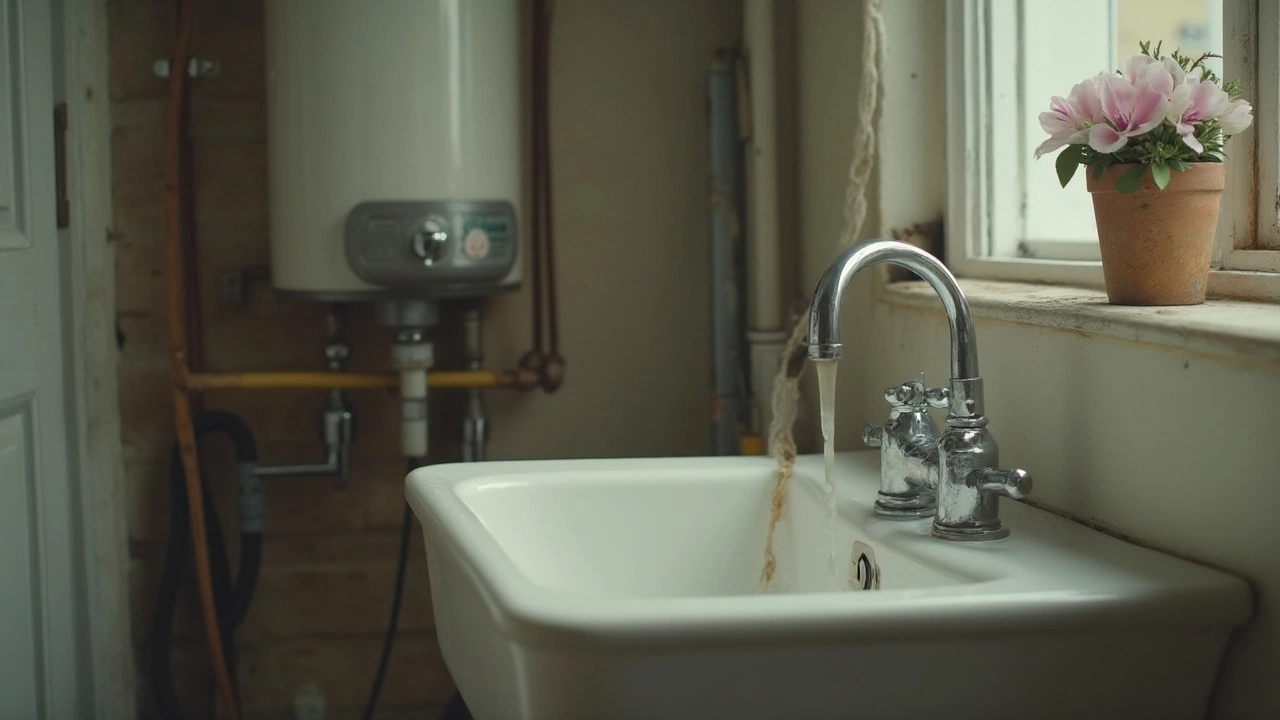
Common Symptoms vs. Simple Fixes
Water heaters throw out signals when they're struggling, but not all problems mean you need a new system. Some signs just need a quick fix, while others scream replacement. Let’s sort out which is which.
- No hot water? This feels dramatic, but it’s not always a death sentence. It could be a blown thermostat or a tripped circuit breaker—easy and cheap to replace. But if the burner won’t stay lit or the pilot keeps going out after fixes, the issue may be deeper.
- Lukewarm water is super common and frustrating. Sometimes, it’s just a thermostat set too low. Crank it up a few degrees before panicking. If the water is still tepid after tweaking settings, your heating element could be burned out, especially in electric heaters. Elements rarely cost more than $50 to swap.
- Rusty or discolored water from the hot tap is a big hint something’s going south inside the tank, especially if it clears up when you run cold water. Try draining a few gallons out of the tank using the drain valve—if it stays rusty, the inside is probably corroding, and it’s time to think about a replacement.
- Strange noises like crackling, popping, or banging usually point to sediment buildup. Flushing the tank once a year clears out extra minerals and keeps everything running smoother. If flushing doesn’t stop the racket, the leftover sediment is probably too thick, which strains the tank and speeds up failure.
- Leaks around the base are almost never good news. A little moisture could be from loose connections or condensation, but steady puddles often mean the inner tank is leaking. At that point, repairs really aren’t worth it—your hot water heater’s at the end.
Here’s a quick look at what repairs cost and when experts usually throw in the towel:
| Symptom | DIY Fix | Average Repair Cost | Usually Means Replacement? |
|---|---|---|---|
| No hot water | Check/reset breaker or thermostat | $100-$200 | No, unless heating element fails again |
| Lukewarm water | Adjust thermostat, replace element | $150 | No, if fixed by part replacement |
| Rusty water | Drain tank, replace anode rod | $100-$250 | Yes, if rust persists after draining |
| Strange noises | Flush tank | $80-$100 | Yes, if noise continues after flush |
| Leaks at base | Check for loose fittings | — | Yes, if tank is leaking |
Don’t just keep fixing the same problem over and over. If repairs don’t last long or costs keep stacking up, your hot water heater probably needs to be replaced. Not only will you save on stress, but a new system will also cut down on utility bills and prevent nasty surprises.
Why Replacement Beats Constant Repair
It’s tempting to fix that old water heater one more time and put off a replacement, but constantly patching problems can hurt more than your wallet. Repairs might seem cheaper, but over time, the costs add up fast—especially after your unit hits ten years. According to the U.S. Department of Energy, the average lifespan of a traditional tank water heater is about 8 to 12 years. After that, issues start popping up quicker and repairs become more frequent (and expensive).
Let’s face it: older heaters are less energy-efficient. They use more gas or electricity to get the same job done, which shows up on your bill every month. New models can cut that monthly cost by 10-20%. If you find yourself calling in a plumber every year, or even every few months for leaks, heating problems, or pilot light issues, that’s money you could have put toward a brand-new unit.
Check out the real difference when you’re choosing between fixing or swapping out your tank:
| Typical Repair Cost (each) | Avg. Annual Repairs (older units) | Annual Total | |
|---|---|---|---|
| Heating element replacement | $200 | 1 | $200 |
| Leaky valve fix | $125 | 2 | $250 |
| Pilot light issues | $140 | 1 | $140 |
| Hot water heater replacement (one-time) | $1,200–$2,000 (lasts 8–12 years) | ||
Beyond the money, there’s the headache factor. Repeated breakdowns can lead to water damage, mold, or unexpected freezing cold showers—especially if your heater dies in the middle of winter. Sometimes, small leaks go unnoticed right up until that tank bursts and floods a room.
An upgrade isn’t just about sidestepping repairs. New heaters are safer and can come with useful features like better insulation, quick-recovery times, or digital controls. And since modern energy standards kicked in, new units have to meet higher efficiency benchmarks—so you get more hot water, for less money, with a lot fewer surprises.
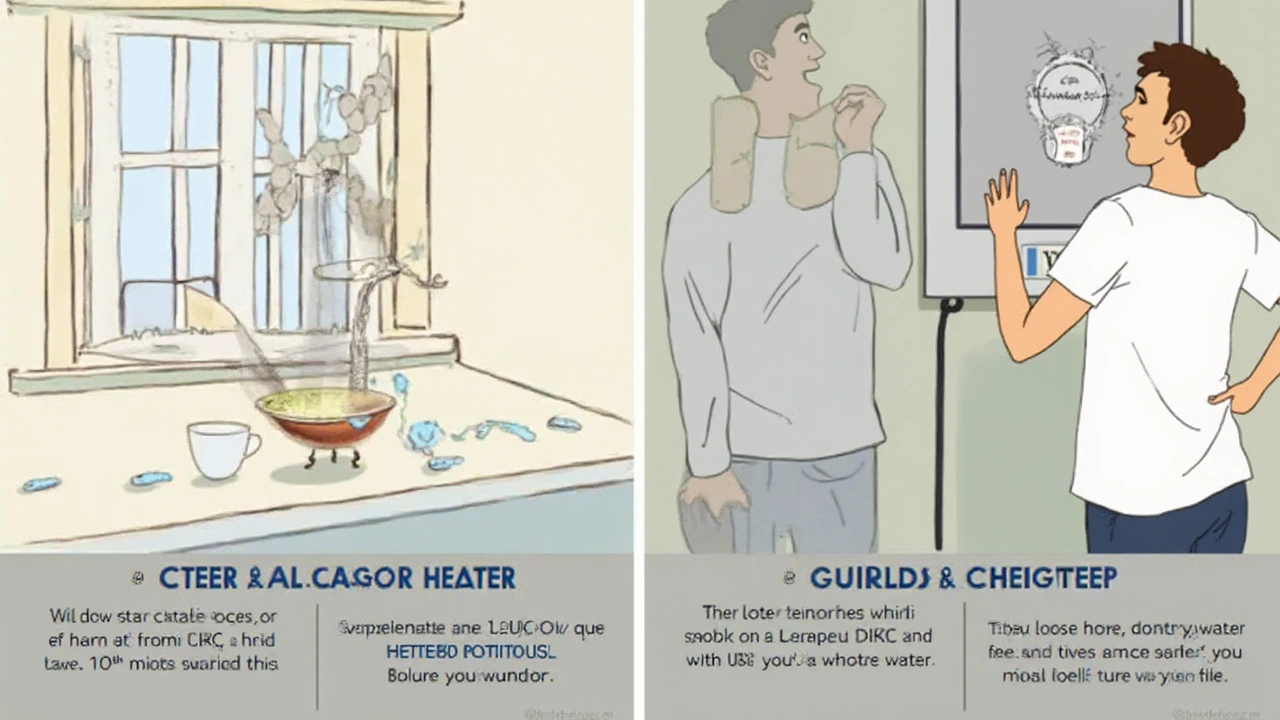
Smart Tips to Stretch Your Heater’s Life
Most people don’t think about their hot water heater until something goes wrong. Truth is, a few minutes of care each year can squeeze extra years out of your tank. Here’s what actually helps—and what’s just hype.
- Hot water heater tanks need regular flushing. Draining a couple gallons from the tank every six months removes sediment that builds up at the bottom. This prevents noisy operation, slower heating, and even possible leaks that kill your heater before its time.
- Check the temperature setting. Keeping it around 120°F cuts your energy bill, fights off scale buildup, and stops scalding water from blasting out of your taps.
- Replace the anode rod every 3-5 years. This part rusts away so the inside of the tank doesn’t. When the rod’s totally gone, the tank starts to eat itself from the inside out. You can usually swap it out without draining the whole tank.
- Look over your heater for drips, rust, or weird corrosion marks every couple of months. Quick fixes now can dodge big repairs or replacements later.
- Insulate exposed pipes and maybe even the tank (unless it’s already foam insulated). You’ll lose less heat and help your heater work a little less for the same hot water.
Wondering how much home maintenance can really change things? Check out the numbers below:
| Maintenance Task | Average Lifespan Increase |
|---|---|
| Annual tank flush | +2-3 years |
| Anode rod replacement | +3-5 years |
| Lowering temperature | Up to 10% energy savings yearly |
No secret hacks and no gadgets needed—just basic upkeep. Skip these steps, and you could end up paying for a new heater every eight years instead of squeezing ten to fifteen out of your existing one.

